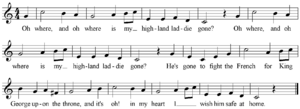Bluebells of Scotland facts for kids
"The Bluebells of Scotland" is a very old and popular Scottish folk song. It was written by Dora Jordan, an English actress and writer. The song was first shared with the public in 1801. It tells a story that many people still enjoy today.
Contents
Different Song Versions
Like many old folk songs, "The Bluebells of Scotland" has changed over time. This means there are a few different versions of its words.
Early Song Lyrics
One early version was printed in 1803. It appeared in a book called the Scots Musical Museum. This version had a slightly different tune than the one we know today. The words were about a "highland laddie" (a young man from the Scottish Highlands).
The song asked where he lived. It said he lived in Scotland where "bluebells sweetly smell." The singer also said they loved their laddie very much.
Later Song Lyrics
A bit later in the 1800s, another version became popular. This was a "broadside ballad." A broadside ballad was like a newspaper poster with song lyrics. It was printed on a large sheet of paper and sold cheaply.
This version mentioned real historical events. It talked about King George III, who was the king of Great Britain at the time. It also mentioned the Napoleonic Wars. These were big wars fought between France and many other European countries.
In this version, the song asks where the highland laddie has gone. The answer is that he has gone to fight the French for King George. The singer wishes for him to come home safely.
What is a Bluebell?
The "bluebell" in the song's title refers to a beautiful flower. There are different types of bluebells. One common type is the Common bluebell. Another is the Campanula rotundifolia. Both have lovely blue bell-shaped flowers.
The Song's Tune
Musical Arrangements
Many musicians have created their own versions of "The Bluebells of Scotland." These are called "arrangements." An arrangement is when a composer takes an existing tune and writes new music for different instruments.
Joseph Haydn's Arrangement
A famous composer named Joseph Haydn wrote an arrangement for this song. He created a piano trio accompaniment for it. This means he wrote parts for a piano and two other instruments to play along with the song.
Arthur Pryor's Trombone Version
One of the most famous arrangements was made by Arthur Pryor. He was a very skilled trombone player. His version is usually called "Blue Bells of Scotland." It is played by a solo trombone with other instruments. These can be a piano, a band, or even an orchestra. Pryor likely wrote this piece around 1899.
Challenging for Trombonists
Pryor's arrangement is very difficult to play. It lets the trombone player show off their skills. They need to play smoothly (legato) and make big jumps between notes. The piece also requires playing many notes very quickly.
The song starts with a fancy introduction called a "cadenza." Then, the main tune (theme) is played. After that, there are several "variations." Each variation changes the tune in a new, challenging way. For example, one part has fast groups of three notes (triplets). Another has tricky rhythms.
The cadenza near the end is very impressive. It shows how high and low the player can go on the trombone. Because it is so hard, only the best trombonists can play it. Famous players like Joseph Alessi and Christian Lindberg have recorded it. Many musicians think it's like the "Carnival of Venice" for trumpet players. Both pieces require amazing mastery of the instrument.
Other Famous Arrangements
- Leroy Anderson: An American composer named Leroy Anderson also arranged the tune. He included it in his "Scottish Suite" in 1954. His version is bright and lively, often played by high strings and woodwind instruments.
- Bing Crosby: The famous singer Bing Crosby included the song in a medley. A medley is a group of songs played one after another. It was on his album 101 Gang Songs in 1961.
- Bagpipe Bands: Many bagpipe bands play arrangements of "The Bluebells of Scotland." They often play it as part of a medley with other tunes.


